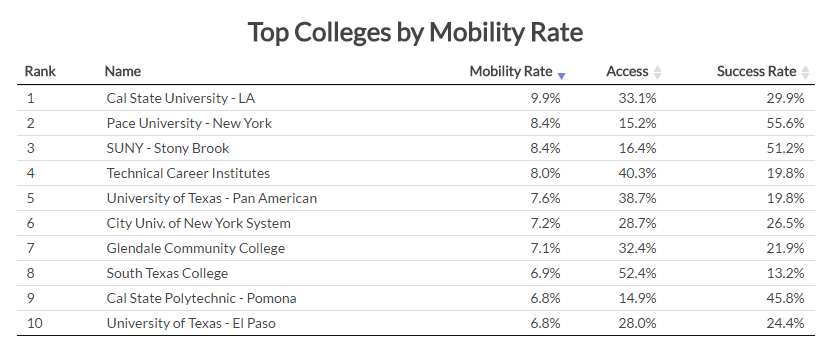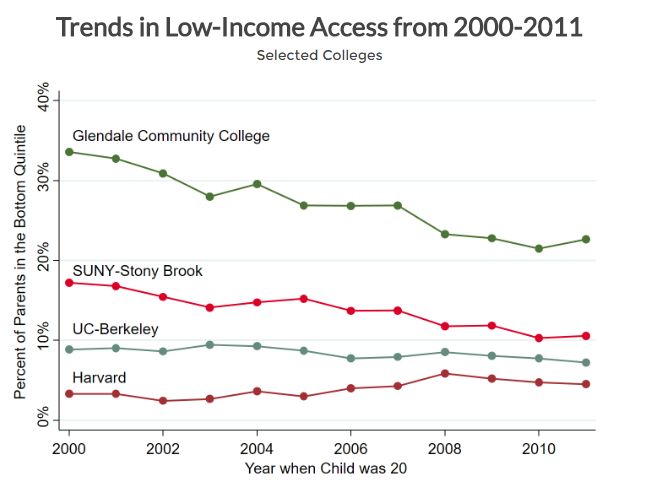It’s not necessarily the schools you’d expect.
By Dwyer Gunn
(Photo: Wikimedia Commons)
On Wednesday, economist Raj Chetty’s Equality of Opportunity project, which in recent years has produced quite a few blockbuster revelations on mobility in the United States, published a new paper on college and economic mobility. The paper — by Chetty and co-authors John Friedman, Emmanuel Saez, Nicholas Turner, and Danny Yagan — was accompanied by “mobility report cards” for almost every college in America.
The research contains a number of fascinating tidbits. For starters, the most elite colleges enroll lots of rich kids, and not very many poor kids. “At ‘Ivy-Plus’ colleges (Ivy League colleges, U. Chicago, Stanford, MIT, and Duke), more students come from families in the top 1 percent of the income distribution than the bottom half of the income distribution,” a research summary concludes. “Despite the generous financial aid offered by these institutions, students from the lowest-income families are particularly under-represented, even relative to middle-income students. Children with parents in the top 1% are 77 times more likely to attend an Ivy-Plus college than children with parents in the bottom 20%.” (The New York Times’ Upshot has some excellent graphics illustrating where children from different brackets go to school.)
In general, low-income children who do snag a spot at those elite schools enjoy high earnings after college, almost as high as their wealthier peers, which suggests these colleges do, in the researcher’s words, “level the playing field.”
Chetty and his co-authors also constructed a metric to identify schools that perform well, both on measures of access (the number of low-income students they serve) and success (the outcomes of students). They call this metric the college mobility rate, which they defined as “the fraction of [a school’s] students who come from a family in the bottom fifth of the income distribution and end up in the top fifth of the income distribution.” The chart below, from the Equality of Opportunity website, lists the colleges with the highest mobility rates:

(Chart: Equality of Opportunity)
These schools — which manage to both launch low-income students into a higher income bracket and serve large percentages of low-income students — are mostly mid-tier public schools. Elite private schools don’t score as well on this metric because they serve so few low-income students; most two-year community colleges, meanwhile, score poorly because students don’t do very well after attending them.
Interestingly, “Ivy-plus” schools register best at launching low-income children into the top 1 percent. In fact, the researchers didn’t find a single U.S. college that both enrolled significant numbers of low-income students and produced large numbers of graduates with incomes in the top 1 percent of the income distribution. But, for the vast majority of low-income students, who are likely more concerned with making it into the top 20 percent of the income distribution than the top 1 percent, as well as policymakers concerned with higher education policy, the Chetty paper suggests low-income students don’t have to go to Harvard University to achieve economic stability.
“[E]xpanding access to the high-mobility-rate colleges identified here may provide a more scalable model for increasing upward mobility for large numbers of children,” Chetty and his co-authors write. “The colleges with the highest mobility rates have annual instructional expenditures less than $6,500 per student on average, far lower than the $87,000 per student spent on instruction at elite private colleges.”

Now, the bad news: Since 2000, it’s become harder for low-income students to attend those schools. As the chart to the left illustrates, the percentage of low-income students attending mobility-rate powerhouses like Glendale Community College and the University of California–Berkeley has plummeted in recent years.
The researchers hypothesize the trend might be due to recent tuition increases and declines in state funding, and suggest that it might be time for “a re-evaluation of policies at the national, state, and college level.”





